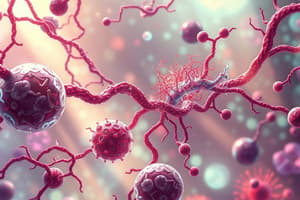Podcast
Questions and Answers
Which of the following correctly defines an organ?
Which of the following correctly defines an organ?
- The smallest structural unit of the body
- A group of similar cells that perform the same function
- A system of organs that coordinate bodily functions
- A collection of tissues that work together to perform a specific function (correct)
What is the study of tissues called?
What is the study of tissues called?
- Anatomy
- Physiology
- Histology (correct)
- Cytology
Which term refers to the process of breaking down complex nutrients to simpler substances?
Which term refers to the process of breaking down complex nutrients to simpler substances?
- Catabolism (correct)
- Photosynthesis
- Metabolism
- Anabolism
Which of the following is NOT one of the four main types of tissues?
Which of the following is NOT one of the four main types of tissues?
In terms of cellular structure, what does the term 'cytoplasm' refer to?
In terms of cellular structure, what does the term 'cytoplasm' refer to?
What is the primary function of the cell membrane?
What is the primary function of the cell membrane?
Which of the following statements about DNA is correct?
Which of the following statements about DNA is correct?
Which statement about metabolism is accurate?
Which statement about metabolism is accurate?
What is the primary role of tissues in the body?
What is the primary role of tissues in the body?
Which specializes in the study of cells?
Which specializes in the study of cells?
Which of the following best defines metabolism?
Which of the following best defines metabolism?
What are chromosomes primarily responsible for?
What are chromosomes primarily responsible for?
Which organ system is primarily responsible for nutrient absorption?
Which organ system is primarily responsible for nutrient absorption?
What best describes the function of the cell membrane?
What best describes the function of the cell membrane?
What is the primary role of a histologist?
What is the primary role of a histologist?
Which of the following statements about the respiratory and circulatory systems is true?
Which of the following statements about the respiratory and circulatory systems is true?
Study Notes
Structure of the Body
- From smallest to largest: cells, tissues, organs, body systems.
- These structures work together to form the body and allow it to function.
Cells
- Basic structural and functional units of the body.
- Specialized cells group together to form tissues and organs.
- Cytology is the study of cells, including their anatomy, physiology, pathology, and chemistry.
Terms Related to Cells
- Anabolism: Building up large proteins from smaller amino acid pieces.
- Catabolism: Breaking down complex nutrients into simpler substances and releasing energy.
- Cell Membrane: Surrounds and protects the cell, controlling what enters and leaves.
- Chromosomes: Rod-shaped structures in the nucleus containing DNA regions called genes.
- Cytoplasm: All the material outside the nucleus but within the cell membrane.
- DNA: Chemical found within each chromosome.
- Metabolism: All the chemical processes in a cell, including catabolism and anabolism.
Tissues
- Groups of similar cells performing the same role, with at least one unique function.
- Classified by structure and function, divided into four types: epithelial, connective, muscle, and nervous.
- Histology is the study of tissues, their structure, composition, and function.
Histology
- Used during autopsies and forensic investigations to understand unexplained deaths.
- A histologist is a specialist in studying the organization of tissues at all levels.
Cells
- Cells are structural and functional units of the body
- Cells are specialized and grouped to form tissues and organs
- Cytology is the study of the anatomy, physiology, pathology, and chemistry of the cell
- Anabolism is the process of building up large proteins from smaller protein pieces called amino acids
- Catabolism is the process where complex nutrients are broken down into simpler substances, releasing energy
- Cell membrane surrounds and protects the cell, determining what enters and leaves
- Chromosomes are rod-shaped structures in the nucleus that contain DNA regions called genes
- Cytoplasm is all material outside the nucleus but inside the cell membrane
- DNA is a chemical found within each chromosome
- Metabolism is the total of chemical processes in a cell, including catabolism and anabolism
Tissues
- Tissues are groups of similar cells that perform the same role
- Each tissue has at least one unique function
- Tissues are classified by structure and function, and are divided into four types: epithelial, connective, muscle, and nervous
- Histology is the study of the structure, composition, and function of tissues
- Histology is used during autopsies and forensic investigations to understand unexplained deaths
- A histologist is a specialist in the study of the organization of tissues at all levels
Studying That Suits You
Use AI to generate personalized quizzes and flashcards to suit your learning preferences.
Related Documents
Description
Explore the fundamental structure of the body in this quiz, starting from cells to tissues, organs, and body systems. Understand key terms related to cell anatomy and metabolism, including anabolism, catabolism, and DNA. Perfect for reinforcing your knowledge of biological organization.




